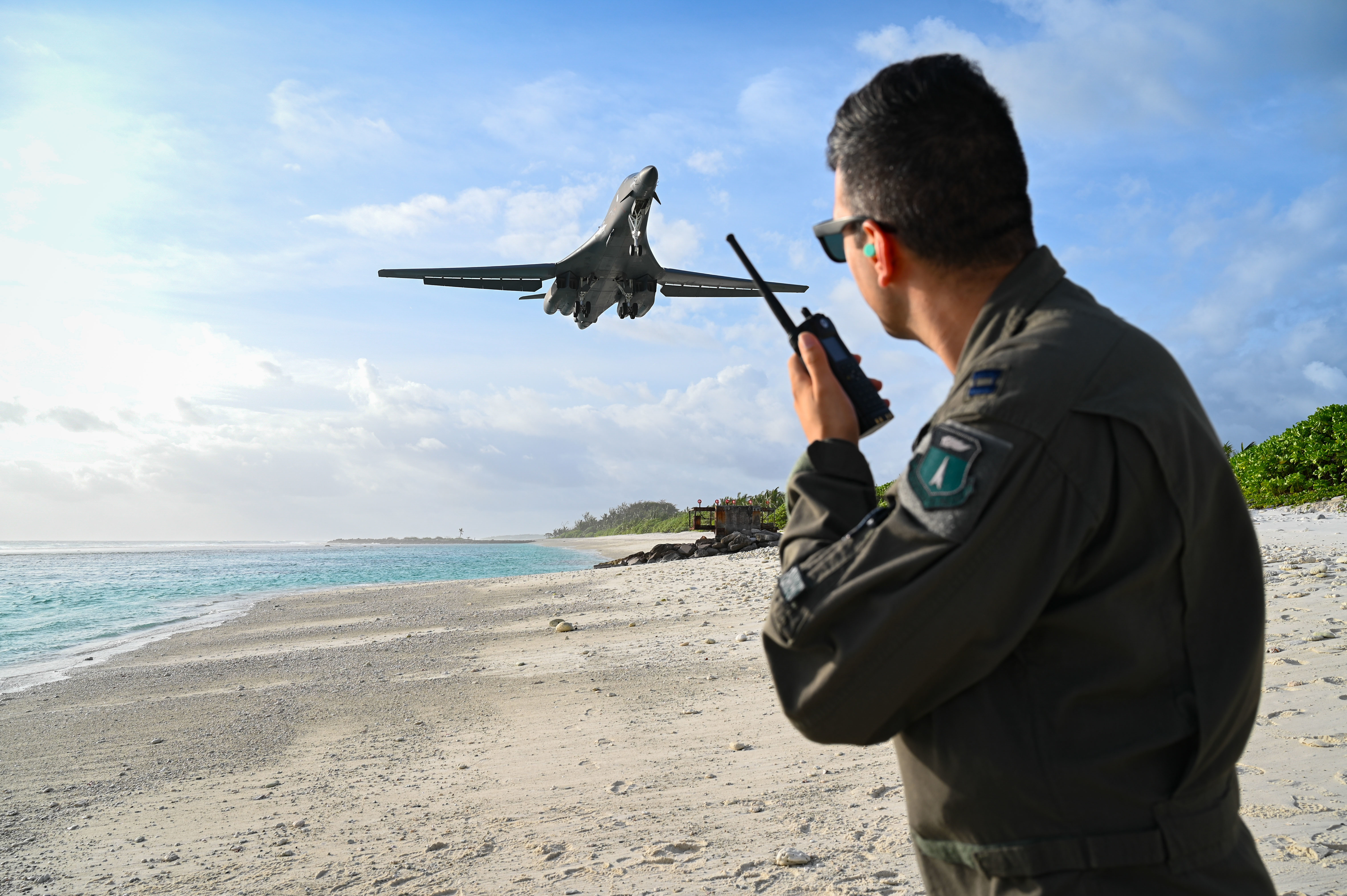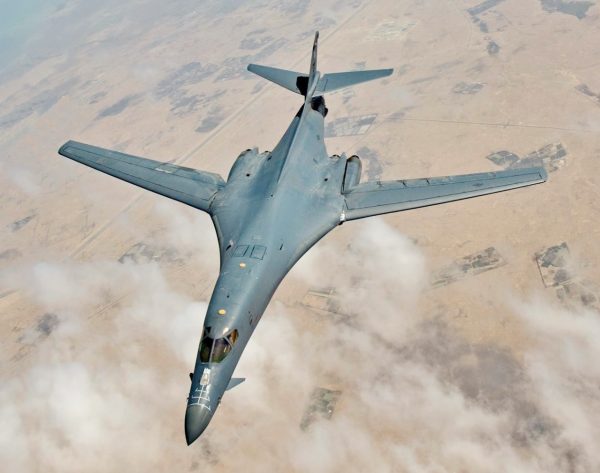The US and allied forces have shifted their focus to the Indo-Pacific amid Chinese aggression in the region. A British carrier strike group led by HMS Queen Elizabeth is currently sailing through the Arabian Sea while the US Air Force has deployed its swing-wing bombers — B-1 Lancers — to a remote island outpost in the Indian Ocean, the first time in 15 years.
‘Grossly Outranged’ By Chinese Air-To-Air Missiles, US Accelerates Development Of New-Age Missiles For Its Fighter Jets
According to reports, British F-35Bs made a vertical landing on the Royal Navy aircraft carrier HMS Queen Elizabeth in the Arabian Sea near Mumbai. The warship is taking part in a joint exercise with the Indian military.
A video tweeted by the British High Commission in India showed a Lockheed Martin fifth-generation fighter jet lowering itself vertically on the deck of the carrier before a touchdown. A similar video was tweeted by news agency ANI.
Namaste ? India ??!
The UK's ?? Carrier Strike Group, led by @HMSQNLZ ? is here! #CSG21 pic.twitter.com/rcckass4Dj
— UK in India???? (@UKinIndia) October 21, 2021
The F-35B is a short takeoff and vertical landing (STOVL) stealth fighter jet. These aircraft are used by United States Marine Corps (USMC), the UK Royal Navy, and the Italian Air Force, according to the company website.
The F-35B shares 70%-90% commonalities with the other two variants of F-35 Lightning II — land-based F-35A and naval variant F-35C.
#WATCH | F-35B fifth generation fighter aircraft lands vertically on the British Royal Navy aircraft carrier HMS Queen Elizabeth in Arabian Sea near Mumbai. Warship is in India for a joint exercise with Indian forces. pic.twitter.com/2PwkA9PTtL
— ANI (@ANI) October 21, 2021
US Bombers Reach Diego Garcia
The Boeing B-1B Lancer is the USAF’s long-range strategic bomber. The aircraft became operational in 1986 and has the largest internal payload as compared to any current bomber. In July 2001, the US Department of Defense announced plans to cut down its B-1B inventory from 92 to 67 as a cost-saving measure.
As part of this move, the first aircraft was removed from service in August 2002. The DoD decided that it should have 67 aircraft in its fleet after ‘Operation Iraqi Freedom’. Of these, 38 are operated from the Dyess Air Force Base in Texas and 29 from the Ellsworth Air Force Base in South Dakota.
F-22 Raptor Vs NGAD: How Does US’ 6th-Gen Fighter Jet Compete Against World’s Best Warplane — F-22 Raptor?
Owing to its low radar cross-section, variable-geometry wings, advanced avionics, and its afterburning engines, the B-1 bomber is capable of carrying the largest payload strike while offering long-range, maneuverability, high speed, and survivability. The aircraft has been projected to remain in service until the year 2040.
The bomber can attain a maximum speed of 1,448 km/h. Its service ceiling is 9,144 kg and it weighs approximately 86182 kg with a maximum takeoff weight of 216,363 kg.
Significance
The USAF has deployed its B-1B Lancer strategic bombers to Diego Garcia, an island outpost in the Indian Ocean. This is the first time that the aircraft has been deployed at this location since 2006.
Also known as the ‘Bones’, the aircraft have been sent halfway around the world to this remote airfield as a part of the Pacific Air Force’s (PACAF) Bomber Task Force (BTF) mission.

These bombers have arrived at a time when the tensions in the Asia-Pacific region are at a high due to Chinese military activity in the Taiwan Strait. The deployment of the B-1s along with 200 airmen to the Naval Support Facility Diego Garcia, a US military base in British Indian Ocean Territory, was announced by the Pentagon on October 19.
The bombers for this mission belong to the 28th Bomb Wing at the Ellsworth Air Force Base in South Dakota.
Replacing Rafales & Typhoons – How French ‘Strategic Autonomy’ Is A Bane For 6th-Gen FCAS Jet & Boon For British Tempest
The bombers arrived at Diego Garcia on October 17, according to the caption of the images released by the DoD. Even though the number of bombers deployed for the BTF mission has not been stated by the DoD, satellite images show three B-1B aircraft on the airfield on October 18 and October 21.
The B-1B bombers were earlier deployed to Diego Garcia in 2006. However, in May 2006, one of the planes, serial number 86-0132, suffered serious damage after it made a wheels-up landing. The Diego Garcia airfield had been largely used by B-1s, B-52s and B-2 stealth bombers during the strikes in Afghanistan in the first decade of the war on terror.

“Bomber Task Force missions, in support of [U.S. Indo-Pacific Command’s] operational and strategic objectives, are extremely valuable to our aircrew because of the multi-country integration opportunities”, said Lieutenant Colonel Ross Hobbs, 37th Bomb Squadron director of operations, in a statement released by the DoD regarding the current deployment of B-1 to Diego Garcia.
New Headache For India? China’s ‘Most-Powerful’ Missile Defense System Likely To Be Deployed Along Both LAC & LOC
“They also give us the opportunity to showcase the unmatched range, speed, and lethality of the B-1. Global B-1 operations not only provide strategic deterrence to our nation’s adversaries but also strong, palpable assurance to our allies”, Hobbs further stated.
Powered By ‘On The Fly’ Algo, China Says Its AI-Controlled Hypersonic Missiles Can Hit Targets With 10 Times More Accuracy
Mission Objectives
Although details of the latest mission have not been revealed, the Pentagon has promised of “multiple sorties […] in support of multiple geographic combatant command objectives and training requirements”. BTF missions are seen as a way of demonstrating the US military’s commitments to its allies in various regions.
At present, the B-1 bombers have also been deployed at the RAF Fairford in England as part of a European BTF mission. During this deployment, the B-1s have conducted various long-range missions over the Black Sea, a region that has been witnessing tensions between NATO and Russia.
Russian Su-30 fighter jets intercepted 2 USAF B-1B bombers over Black Sea https://t.co/3LaFWQHruE pic.twitter.com/Qs3kc0aQsR
— Liveuamap (@Liveuamap) October 20, 2021
The arrival of these B-1B Lancers at Diego Garcia further highlights increased activity by the US and allied across the Indo-Pacific. British aircraft carrier HMS Queen Elizabeth along with its Carrier Strike Group 21 (CSG21) has reached the Arabia Sea.
Zooming At Mach 5 Speed, China’s ‘Untraceable’ Orbiting Nuclear Missiles Present Grave Threat To Global Democracies?
Meanwhile, China’s People’s Liberation Army Air Force (PLAAF) has been largely active in the Taiwan Strait. A record number of Chinese 56 aircraft had entered Taiwan’s Air Defense Identification Zone (ADIZ) in a single day, earlier this month.
The duration of B-1B deployment at Diego Garcia is not yet revealed, however, it is likely that the US Air Force will be demonstrating the aircraft’s long-range capabilities in the Indo-Pacific region. The deployment at Diego Garcia not only provides the ‘Bones’ with a strategic location for conducting exercises with friendly regional powers but also places the aircraft ‘firmly’ within the reach of potential hotspots as well.
- Written by Kashish Tandon/EurAsian Times Desk
- Contact the author at: kashishtandon21@gmail.com
- Follow EurAsian Times on Google News




